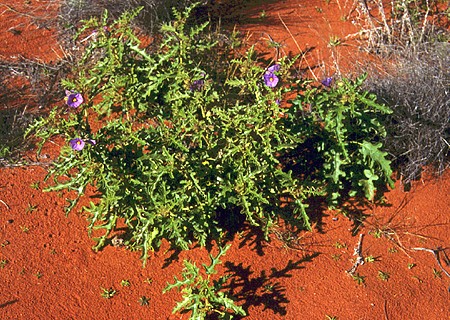
Synonymy
Solanum petrophilum F. Muell., Linnaea 25: 433 (1853)
T: Cudnaka, Flinders Ranges, S.A., Oct. 1851, F. Mueller s.n.; holo: MEL 12107; iso: MEL 12106.
Description
Intricate, usually erect, clonal shrub to 50 cm, grey-green, occasionally rusty-green, densely pubescent with stellate hairs; prickles to 10 mm long, common on most parts.
Leaves ovate-lanceolate to oblong; lamina 3–6 cm long, 1.5–3 cm wide, sometimes larger, slightly to distinctly discolorous, shallowly to deeply lobed; petiole 5–15 mm long.
Inflorescence 3–10–flowered; peduncle 5–10 mm long, sometimes to 30 mm; rachis to 5 cm long; pedicels 5–10 mm long. Calyx 8–10 mm long; lobes narrowly triangular with linear apices, 6–7 mm long, elongated slightly in fruit. Corolla shallowly campanulate-rotate, 25–30 mm diam., purple. Anthers 4–6 mm long.
Berry globular or depressed globular, 8–10 mm diam., sometimes to 15 mm, yellow, drying pale brown. Seeds 1–1.5 mm long, light brown or grey-brown, finally hard and bony. n=12, 24.
A DELTA-generated description with further inforamtion can be seen at http://delta-intkey.com/solanum/www/petrophi.htm
Distribution and ecology
Associated with ranges in arid areas, occurring in the Coolgardie area of W.A., the Macdonnell, Musgrave and Everard Ranges of Central Australia, the Gawler and Flinders Ranges of S.A., and the Barrier Range of N.S.W.
Grows in rocky habitats or close to the base of ranges.
Common name
Rock Nightshade.
Relationships
Part of the S. hystrix group of subgen. Leptostemonum according to Bean (2004).
Notes
Suspected of poisoning stock in N.S.W. and W.A.
Gawler Ranges populations, as shown in one of the attached images, may have flowers which are less rotate than usual.
There is contrasting information about the fire response of this species on the North Australian Land Manager site. One record indicates that it is killed by fire and hence may be eliminated by frequesnt fires whereas another indicates that it is capable of resprouting - see www.landmanager.org.au/view/317664/fire_responses_of_isolanum_petrophilum/i.html
Selected specimens
W.A.: Cavenagh Range, A.S. George 8741 (PERTH). N.T.: near Kulgera Homestead, 5 Aug. 1954, G. Chippendale (MEL, NT). S.A.: Everard Park, 16 June 1958, J.B. Cleland (AD); 16 km NW of Moonaree Stn, D.E. Symon 3444 (AD, CANB). N.S.W.: Mootwingee, 10 June 1973, P.L. Milthorpe (NSW).
Plant status, if any
Conservation status as a plant of least concern in the
From the web
Information on S. petrophilum in SA can be seen on the eFLORA SA site
Further information on this species in NSW can be seen on the PlantNET site
Further information on this species in WA can be found on the FloraBase site.
A fact sheet for S. petrophilum can be downloaded from the Australian Native Plants Society at http://asgap.org.au/s-qua.html A photograph on the sheet, previously attributed as S. quadriloculatum , shows leaves and flowers.
Information for this species has not yet been added to the Solanaceae Source site.






